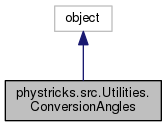Simplify and convert angle units.
This class serves to factorise conversion degree -> radian and radian -> degree
INPUT:
- ``conversion_factor`` - the conversion factor from the considered unit to the other (radian->degree or the contrary)
- ``max_value`` - the maximal value (360 or 2*pi)
| def phystricks.src.Utilities.ConversionAngles.conversion |
( |
|
self, |
|
|
|
theta, |
|
|
|
number = False, |
|
|
|
keep_max = False, |
|
|
|
keep_large = False, |
|
|
|
converting = True, |
|
|
|
numerical = False |
|
) |
| |
Makes the conversion and simplify.
INPUT:
- ``theta`` - the angle to be converted.
- ``number`` - (default =False) If true, return a number. Not to be confused with <numerical>.
- ``keep_max`` - (default False) If true, does not convert the max value into the minimal value. Typically, leaves 2*pi as 2*pi instead of returning 0.
- ``keep_large`` - (default False) if an angle larger that 2pi is given, return an angle larger than 2pi.
- ``converting`` - (defaut = True) If False, make no conversion.
- ``numerical`` - (default = False) boolean. If True, return a numerical approximation. If <numerical>=True, then <number> is automatically switched to True.
EXAMPLES:
For converting 7 radian into degree, make the following::
sage: from phystricks.SmallComputations import *
sage: degree=ConversionAngles(180/pi,360).conversion
sage: degree(7)
1260/pi - 360
Notice that the result is an exact value. If you want a numerical approximation::
sage: degree(7,numerical=True)
41.0704565915763
sage: numerical_approx(degree(7))
41.0704565915763
sage: degree(120,converting=False)
120
Using `converting=False,number=True` is a way to ensure something to be a number instead of a AngleMeasure. For that, we need to precise
what unit we want to produce. This is done by `self.exit_attribute`.
A realistic way to define a function that converts to degree is::
sage: DegreeConversions=ConversionAngles(SR(180)/pi,360,exit_attribute="degree",create_function=DegreeAngleMeasure)
sage: degree=DegreeConversions.conversion
sage: a=45
sage: b=AngleMeasure(value_radian=pi/4)
sage: degree(a,number=True,converting=False)
45
sage: degree(b,number=True,converting=False)
45
| def phystricks.src.Utilities.ConversionAngles.simplify |
( |
|
self, |
|
|
|
angle, |
|
|
|
keep_max = False, |
|
|
|
keep_large = False, |
|
|
|
number = False, |
|
|
|
numerical = False |
|
) |
| |
Simplify the angles modulo the maximum (if 'keep_large'=False, which is default).
If what is given is a number, return a number. If what is given is a AngleMeasure, return a new AngleMeasure.
Keep the negative numbers to negative numbers. The return interval is
[-2 pi,2pi]
which could be open or closed following the `keep_max` boolean.
INPUT:
- ``angle`` - an angle that can be an instance of AngleMeasure or a number. if it is a number, the simplify modulo self.max_value if it is a AngleMeasure, then first extract the value of the angle using self.exit_attribute .
- ``keep_max`` - (default=False) If True, does not simplify the angle with max value. Typically, keeps 2*pi as 2*pi. This is used in order to keep track of the difference between 0 and 2*pi in the context of drawing an full circle.
- ``keep_large`` - (default=False) If True, an angle larger than 2pi remains large than 2pi.
- ``number`` - (default=False) If True, return a number even is a AngleMeasure is given.
- ``numerical`` - (default=False) If True, return numerical_approx of the result
NOTE:
`number=True` allows exit like pi/2 while numerical will return 1.57079632679490.
EXAMPLES::
sage: from phystricks.SmallComputations import *
sage: simplify_degree=ConversionAngles(180/pi,360).simplify
sage: simplify_degree(400)
40
If <keep_max> is True, maximal values are kept::
sage: simplify_degree(500,keep_max=True)
140
sage: simplify_degree(360,keep_max=True)
360
Negative numbers are kept negative::
sage: simplify_degree(-10)
-10
sage: simplify_degree(-380)
-20
sage: simplify_degree(-360)
0
sage: simplify_degree(-360,keep_max=True)
-360


 1.8.11
1.8.11